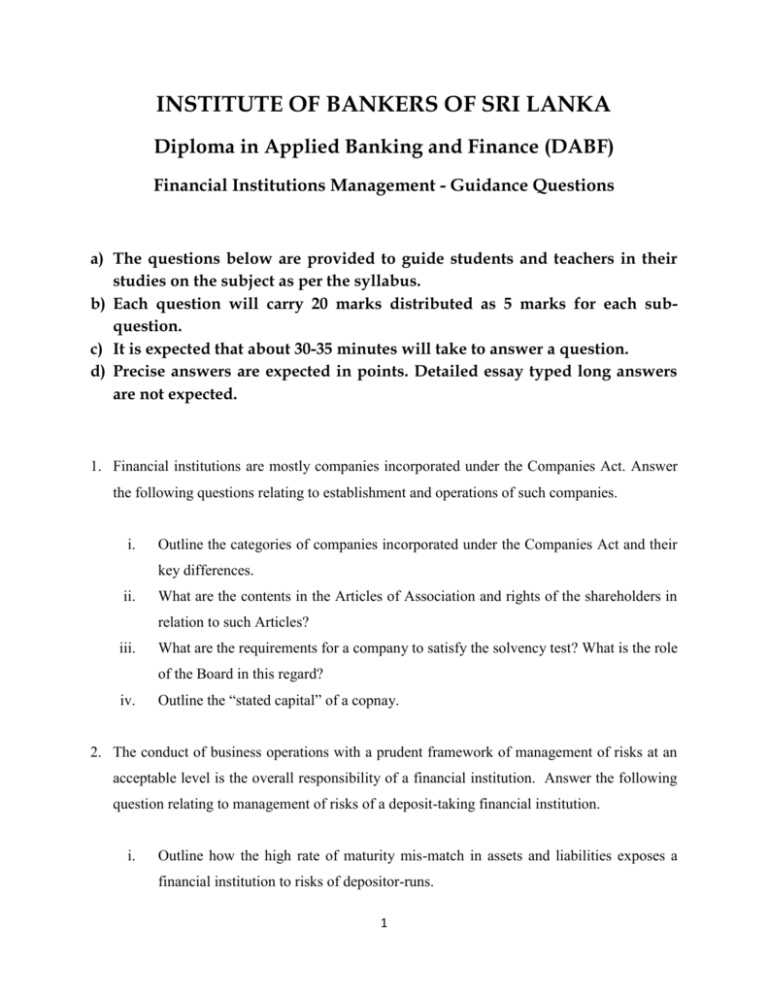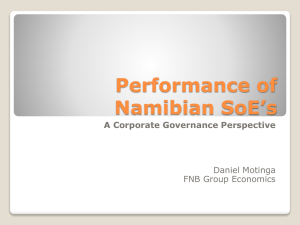Financial Institutions Managment
advertisement

INSTITUTE OF BANKERS OF SRI LANKA Diploma in Applied Banking and Finance (DABF) Financial Institutions Management - Guidance Questions a) The questions below are provided to guide students and teachers in their studies on the subject as per the syllabus. b) Each question will carry 20 marks distributed as 5 marks for each subquestion. c) It is expected that about 30-35 minutes will take to answer a question. d) Precise answers are expected in points. Detailed essay typed long answers are not expected. 1. Financial institutions are mostly companies incorporated under the Companies Act. Answer the following questions relating to establishment and operations of such companies. i. Outline the categories of companies incorporated under the Companies Act and their key differences. ii. What are the contents in the Articles of Association and rights of the shareholders in relation to such Articles? iii. What are the requirements for a company to satisfy the solvency test? What is the role of the Board in this regard? iv. Outline the “stated capital” of a copnay. 2. The conduct of business operations with a prudent framework of management of risks at an acceptable level is the overall responsibility of a financial institution. Answer the following question relating to management of risks of a deposit-taking financial institution. i. Outline how the high rate of maturity mis-match in assets and liabilities exposes a financial institution to risks of depositor-runs. 1 ii. Outline the key measures adopted by financial institutions to mitigate the above risk. iii. What is meant by “internal controls” in a financial institution? List any three internal controls on opening of deposit accounts and accepting cash deposits and state the importance of these to risk management of a financial institution indicating the specific risk to be managed. iv. Outline how capital of financial institutions can be used to manage risks and its limitations as a risk management tool. 3. Several financial frauds have been reported in financial institutions globally from time to time. Answer following questions. i. What is the nature of financial fraud known as a “Ponzi Scheme”? Explain by giving an example from Sri Lanka. ii. Outline three major prudential regulations/requirements that prevent licensed banks and finance companies from being operated as Ponzi Schemes. iii. What is the nature of rogue tradings reported from banks? Explain by giving a recent example from any international bank. iv. Outline the system of three specific offices maintained for trading business in banks to mitigate the risks of possible rogue trading. 4. Corporate governance is a widely discussed topic in management of companies, especially of institutions authorized to engage in deposit-taking business. Answer the following questions on corporate governance of deposit-taking financial institutions. i. Outline the specific description for the corporate governance given in the Directions on Corporate Governance issued by the Central Bank to licensed banks. ii. Outline the major responsibilities of the Board of Directors in corporate governance. iii. Outline the importance of Board-Sub-committees to good corporate governance. Explain by giving examples for such sub-committees. 2 iv. Outline the instances of conflict of interest generally found in governance of financial institutions and their adverse impact. 5. The standard internal governance framework adopted at the management level of a financial institution composes of several key elements/functions such as compliance, risk management, internal audit and management committees. Answer the following questions. i. What are the key functions and responsibilities of the Board of Directors with regard to the above management framework? ii. What are the major issues/problems confronted by the above stated elements? iii. Outline what should be the relationship between the compliance function and internal audit function to ensure the effectiveness of both functions. iv. Outline the standard reporting lines of the followings and specific purpose of such reporting lines. a) Internal Auditor b) Chief Risk Officer c) Compliance Officer d) Credit Committee e) Chief Executive Officer 6. Audit is a key component of the governance system of a financial institution and the audit itself has a specific governance system. Answer the following questions. i. Outline the major difference between the role of the External Auditor and the role of the Internal Auditor. ii. Outline the difference between the Management Letter and Audit Opinion issued by the External Auditor. iii. Outline the purpose of Internal Audit Charter and its major contents. iv. Outline the difference between the Auditor General and a private audit firm with regard to external audit function. 3 7. Audit function plays a significant role for risk management in a financial institution. Answer the following questions in relation to the role of auditors. i. Outline the audit governance framework generally adopted to ensure the independence of the audit from the business operations management. ii. What is the difference between compliance-focused audit and risk focused audit that can be adopted to govern the internal audit? iii. What is the nature of the issue of the conflict of interest relating to audit? How can this issue be avoided? iv. What is the importance of audit on internal controls on financial reporting of a financial institution? 8. Corporate planning is considered as an important process for conduct of business in an organization-wide planned environment in the medium term to long-term. Answer the following questions. i. Differentiate between the vision statement and the mission statement giving appropriate examples for such statements from the real world. ii. What is the importance of setting and publishing corporate values of a company? Give some examples for such corporate values? iii. What is the nature of key performance indicators (KPIs) set in a corporate plan? Give examples for KPIs. iv. Outline how human resource and budgeting functions should be assigned in the corporate plan. 9. It has been the general practice of financial institutions to pursue various strategies for expansion and consolidation in the market. Answer the following questions. i. Outline major methods that can be followed by a financial institution for such expansion and consolidation. 4 ii. Outline the regulatory requirements relating such expansion and consolidation of licensed commercial banks. iii. What are the reasons and objectives of the consolidation plan being implemented by the Central Bank for banking and financial institutions? iv. A financial institution expanding to a financial conglomerate has both benefits and disadvantages? Outline those to the institution, customers and regulators. 10. Mergers, acquisitions and take-overs take place among financial institutions from time to time through various mechanisms. Answer the following questions. i. What are the objectives of such mergers, acquisitions and take-overs? Are those always achieved? Why? ii. What is meant by a hostile take-over? Briefly explain an instance of a hostile takeover attempt on a commercial bank in Sri Lanka reported in the mid of last decade. iii. Outline the provision relating to the “mandatory offer” stated in the “take-overs and mergers code” issued by the Securities and Exchange Commission in Sri Lanka. iv. Outline the mechanism of share-swap in the case of a merger or acquisition. 11. Similar to other companies, financial institutions also are wound-up and liquidated from time to time. Answer the following questions. i. Outline the possible reasons for winding-up a financial institution. ii. Outline the major steps required under the Companies Act for winding-up a company. iii. Who is the liquidation authority in the case of licensed commercial banks? What is the priority order of distribution of liquidation proceeds? iv. In Sri Lanka, liquidation option was not pursued by the Central Bank for many insolvency-threatened finance companies in the recent past. Outline the alternative option known as “bailed-in” followed for such companies. 5 12. Financial statements of financial institutions contain various items of information to serve different stakeholders. Answer the following questions. i. Most Chairmen and CEOs highlight annual performance of their institutions using certain growth rates of financial results such as assets, deposits and profits. Do such growth rates always show a healthy performance of the respective institutions? Why? ii. What are the categories of stakeholders that benefit from the financial ratios of Return on Assets (ROA) and Return on Equity (ROE)? Why? iii. What is the specific importance of leverage ratio and Basel Capital Adequacy Ratio of financial institutions to depositors in understanding risk outlook of such institutions? iv. Outline how shareholders of a listed financial institution benefits from “net assets per share” and Price Earning Ratio (PER). 6







